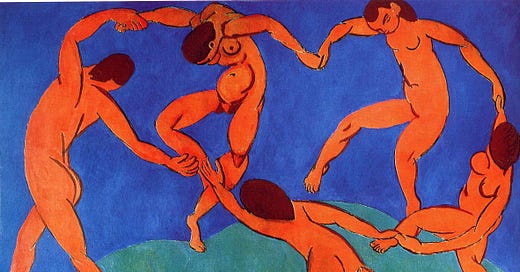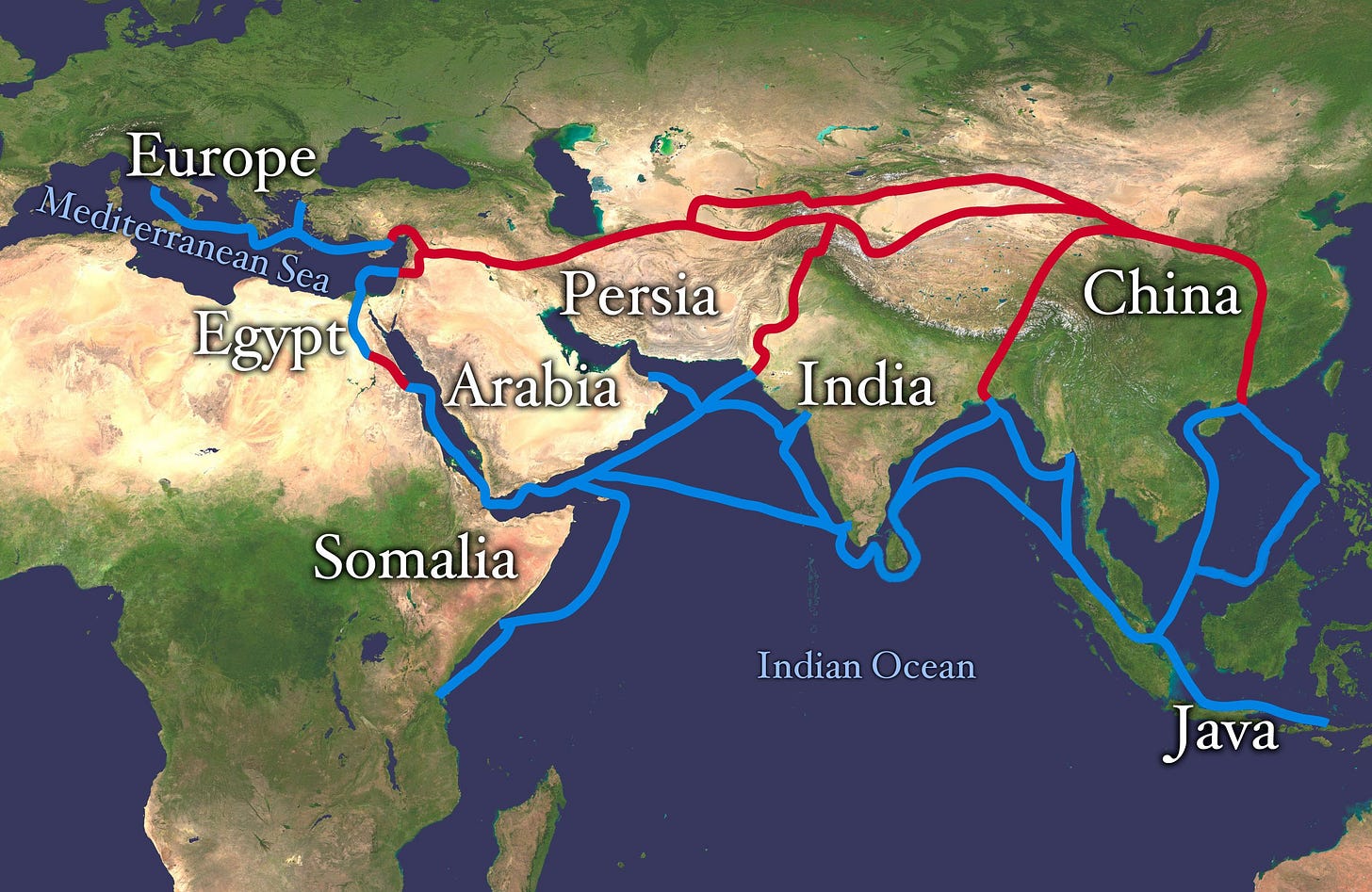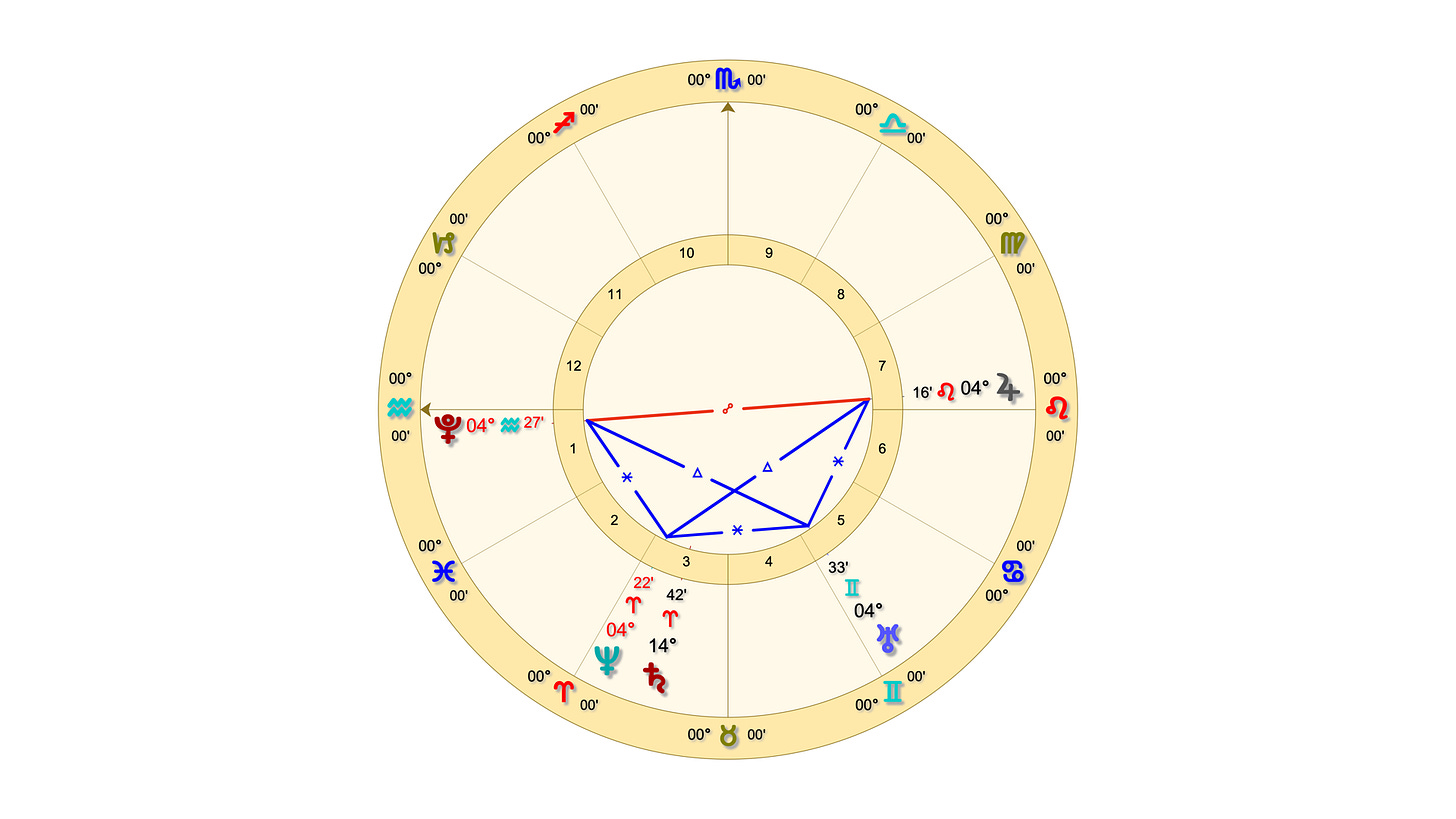Is globalisation—the unprecedented interconnectivity of our world in terms of trade, finance, communications and mobility—breaking down? Are we becoming a truly global society, or is the world fragmenting into walled gardens? Are we coming together or falling apart?
In my last article I noted the fear in media and political science circles over the apparent decline of democracy, both in the United States and beyond. But another, related worry gets just as many headlines these days: the death of globalisation.
In this piece I’m going to explore the astrology of globalisation. In particular, we’re going to consider two astrological factors that speak to this subject: the Age of Air, and the incredible astrology of 2026, which the late, great French astrologer André Barbault called “the most beautiful configuration of the 21st century”.
Let’s dive in.
The pessimism of the times
Peter Zeihan, author of The End of the World is Just Beginning: Mapping the Collapse of Globalization, describes the current moment like this:
2019 was the last great year for the world economy.
For generations, everything has been getting faster, better, and cheaper. Finally, we reached the point that almost anything you could ever want could be sent to your home within days – even hours – of when you decided you wanted it.
America made that happen, but now America has lost interest in keeping it going.
Globe-spanning supply chains are only possible with the protection of the U.S. Navy. The American dollar underpins internationalized energy and financial markets. Complex, innovative industries were created to satisfy American consumers. American security policy forced warring nations to lay down their arms. Billions of people have been fed and educated as the American-led trade system spread across the globe.
Leaving aside the tone of American triumphalism, what’s striking from an astrological perspective is the specific reference to 2019. That’s an interesting year for a non-astrologer to single out.
On the 12th of January, 2020, we saw a Saturn-Pluto conjunction in Capricorn that coincided with the outbreak of Covid-19 in Wuhan. The pandemic had a paradoxical impact on global connectivity: it wreaked havoc on supply chains, grounded flights the world over and forced us to distance ourselves from our fellow human beings. Yet it also drove us towards using technologies—Zoom, Skype et al—that connected us together, albeit through the less visceral, less emotionally satisfying medium of the screen. Consider that period an omen.
At the winter solstice of 2020 came the Great Conjunction of Jupiter and Saturn in Aquarius that ended the 40-year transition from the Age of Earth to the Age of Air. Ages of Earth—at least as far as Europe is concerned—have been periods characterised by growing prosperity, democratic development and the adoption of more materialist conceptions of reality. In the Ages of Air that follow them, ideas that have flowed through the networks built in those prosperous times lead to intellectual golden ages.
Here’s my article on the Age of Air, and here’s a video, in case you need a primer:
The last Age of Air (1186-1425) was the era of thinkers like Thomas Aquinas, Ibn Khaldun and Dogen, among the greatest thinkers in the history of Europe, the Middle East and Japan respectively. It was an educational golden age, when the first universities spread across Europe, democratising access to information.
During this period, traders still plied the legendary Silk Road, the network of trade routes spanning more than 4,000 miles across the Eurasian landmass. It was named for the trade in silk textiles, but also carried tea, dyes, perfumes and porcelain from East to West, and horses, camels, honey, wine and gold from West to East.
Yet the Silk Road also facilitated less desirable kinds of cargo. The bubonic plague, known as the Black Death in Europe, is thought to have been carried from Asia to Europe along those routes. The plague, caused by the bacterium Yersinia pestis, ended up killing an estimated 75-200 million people across Eurasia and North Africa between 1346 and 1353. In a bid to halt the spread of the disease, the authorities of the time severely limited foreign imports. That reduction in trade ended up making people poorer during what were already the hardest of times.
But the plague had consequences that an astrologer of the time may not have seen coming. It killed so many people that it’s generally credited with ending feudalism—a system that had locked everyone, from king to serf, into a rigid socio-economic hierarchy. A structure—an earthy structure—was dissolved, and the medieval world gave way to early modernity.
In the Age of Air of the first millennium (332 - 690), the Roman Empire dissolved, blown to the winds by compounding crises like the Plague of Justinian—the first time bubonic plague blazed across Europe—and climate change. (See Smithsonian’s How Climate Change and Plague Helped Bring Down the Roman Empire and note the ominous resonance there with our current times.) Again, the trade routes built and maintained by the Roman Empire enabled the plague to spread. And when the Roman Empire disintegrated, trade collapsed with it. Yet this Age of Air was also an intellectual golden age, the era of the philosopher Boethius and the theologian Saint Augustine. It was the period that saw Europe’s first cathedral and monastic schools, a great wave of educational democratisation that would be built upon in the next Age of Air.
Our plague-ridden educational golden age
Compare this to our own time, an educational golden age. Some will scoff, but the reality is that tools like YouTube mean it’s possible to learn almost anything using little more than a smartphone. And we’ve had our own bout with a transformative pandemic. Covid-19 spread like wildfire from an outbreak in Wuhan in late 2019 across the entire planet within a few weeks. It’s globalisation—and, in particular, global mobility enabled by the jet engine—that allowed the virus to infect the whole planet so quickly.
With this in mind, I suspect it’s no coincidence that certain facets of globalisation are rolling back in the wake of the pandemic. We’ve been collectively shaken at a profound level. And since that acute phase, more factors have piled on top of that fundamental unease: the war in Ukraine and the return of Great Power rivalry. What we tend to see in elemental ages is multiple seemingly disparate factors all converging to forge the elemental character of the times.
Now look at this recent headline from Fortune magazine:
The article summarises a new report on globalisation from McKinsey, and argues that globalisation is merely changing form:
The 1990s-era hyper-globalization of goods therefore seems well and truly over. The same however cannot be said of ideas: the flow of data and intellectual property continues to break records. As a result, knowledge and know-how are driving global integration, McKinsey said. Flows of services, international students, and intellectual property, for example, grew about twice as fast as goods flows in 2010–19, and that trend continues post-pandemic.
Yes, friends: the Age of Air is very real.
The ‘basket’ of 2026
Now let’s turn to the incredible astrology of 2026, something my recent collaborator S.J. Anderson has christened the “basket”:


The geometry of this configuration—a minor grand trine of Pluto, Neptune and Uranus with the additional testimony of Jupiter in Leo—is truly remarkable. It comes in July 2026, just a few months after a conjunction of Saturn and Neptune at 0° Aries, the first degree of the entire zodiac: talk about new beginnings.
Here’s what André Barbault had to say about 2026 (translated from the French; find the original in this article):
The new world civilisation, the beginnings of which appeared around the year 2000, is in full flight here. This entry into the second quarter of the century bears the stamp of the achievement of a new age of humanity. (…) The central and harmonic position of the Saturn-Neptune conjunction is especially expressive of a promotion of the lower strata of the world population, a significant rise in the standard of living of the poor, a victory over misery won in unprecedented solidarity.
In our video series on the astrology of the 2020s, S.J. and I have delved into the astrology of 2026, as well as some of the other major astrological developments of the 2020s. If you haven’t been following it, here’s the first episode:
Three cycles of connectivity
The basket marks harmonious moments in three key outer-planet cycles:
The sextile of the roughly 492-year Pluto-Neptune cycle, which began with conjunctions in 1891 and 1892 (Pluto and Neptune have been within 6° of a sextile since roughly 1945);
The trine of the 113-141-year Pluto-Uranus cycle, which began with conjunctions in 1965 and 1966;
The sextile of the roughly 170-year Uranus-Neptune cycle, which began with conjunctions in 1993.
All three cycles speak to the themes underlying the slow unfolding of humanity’s grand story: belief, consciousness, technology. But if we look at what was happening around the time of each of these conjunctions—which clues us into the themes of these cycles—we see something very interesting.
First, consider the Pluto-Neptune conjunction of 1891 and 1892, roughly within 15° orb during the final two decades of the 19th century, 1880-1900. This was the dawn of technologies that have been crucial for connecting our globalised world together. In 1890, Clement Ader invented the airplane in the form of the bat-winged “Eole”, the first heavier-than-air powered vehicle. In 1895, Guglielmo Marconi invented the wireless radio. In a sense, this period saw the birth of the modern world of instant connections that we inhabit today.
Now let’s consider the Pluto-Uranus conjunctions of 1965-1966. The two planets were roughly within 15° orb during the 1960s. That decade saw the development of the microchip and the birth of ARPANET, the forerunner of the Internet. It was also the period of the civil rights movement in the United States and the great wave of decolonisation in Africa and other parts of the world: moves away from hierarchical colonial domination and towards the equality of peoples and nations.
And then we have the Neptune-Uranus conjunctions of 1993. That very year saw the public release of the world wide web.
We can see, then, that all three of these cycles saw the birth of technologies essential to the globally connected world we live in today. And in 2026, we’ll reach harmonious moments in all three of these cycles. All three of them are still waxing, meaning they’re in their increasing phases. Their full flowering is yet to come. Like it or not, this strongly suggests that the world we’re heading towards will be far more connected than that of today. The distances between us will become increasingly irrelevant.
Putting it all together: hope for the future
Most of us who aren’t deeply invested in the current global system realise that humanity’s current way of operating cannot go on as it is, given our rampant destruction of the natural environments of our planet, and the potentially dangerous emissions of greenhouse gases that so much production entails.
The amount of energy that goes into ferrying goods across the planet—ensuring that, say, someone living in Britain can find mangoes in the supermarket—is enormous. The International Energy Agency (IEA) says that 37% of CO2 emissions come from freight and transport. A less globalised world—in trade—could reduce those numbers dramatically. Transitioning in this direction is going to be painful—but not terminal. I think we’re far more adaptable than we give ourselves credit for. And perhaps we’ll find ways to generate energy cleanly and cheaply enough that we can grow mangoes in Britain.
At the same time, the world of the future will, I believe, be an even more connected world. Imagine a world where you can meet virtually with anyone else on the planet, with photorealistic clarity, and where language differences are automatically erased by translation technology. That’s where we could be heading.
This growing connectivity can only lead towards an increasingly global mentality and consciousness. Yet the symbolism of the Age of Air suggests this could be a world without a centre: a decentralised world. Needless to say, arriving at a world of this kind will involve upsetting the apple carts of powerful vested interests. That is why this decade will be one for the ages.
This is not the only possible future, and some will think it naïve. It may be. But if we cannot take hope from the astrology of 2026, we cannot take hope at all.
Thanks for reading! Want to get a better idea of how the coming years look for you? I use modern and traditional astrological techniques to give my clients insight about their past, present and future, and help them find purpose and peace of mind in this turbulent world. My books are currently open.









Such a great article. Thank you!!
I really enjoyed this article. 😊